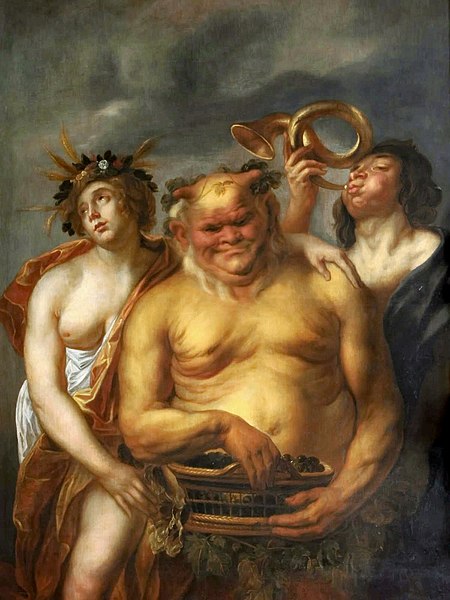While widespread, worship of Serapis was mostly confined to Egypt, where the cult was first formulated by Ptolemy I who wished to create a new patron deity for the city of Alexandria. IIRC, Serapis was created as a synthesis of Enki, the Sumerian god later adopted by the Babylonians as Ea, and the traditional Greek god Hades. Serapis would later become the consort of Isis, another Egyptian deity whose worship would be adopted by the Romans.I did get to reading about the Eleusinian Mysteries whilst researching the Bacchic ones, although I'm not clued up on Serapis or Cybele. Were they particularly well-spread? Eleusinian seems an obvious addition as it was apparently the major mystery religion, but I didn't add it in v1.0 because I hadn't researched it yet. Originally I was only going to add Mithraism (hence the mod name) but then I got reading about Dionysus and the Bacchics/Orphics, and thought Pythagoreanism was something interesting and unique to round off the mod.
A Serapeum, or place of worship for Serapis, would be built in Alexandira by Ptolemy III, but in reality the first Serapeum to be used was located near Ṣaqqārah along the west bank of the Nile. Originally a place of worship for Aspis bulls, sacred animals of the Egyptian god Ptah, the site would be converted to a place of worship for Serapis. During the Imperatorial era of Rome, the Temple of Isis and Serapis was built, but would not be used for worship until the reign of Caligula. Serapis worship was present in Rome from at least the second century on, probably a result of cultural diffusion from Egypt, but was not sanctioned by the state until Caligula. Augustus and his successor Tiberius both opposed his worship.
An interesting curiosity to consider is the depiction of Serapis on Roman coinage. Serapis appears on the coinage of Elagabalus, Septimius Severus, Severus Alexander, Commodus, Gordian III, Caracalla, Maximinus II, and many others beginning with (I believe) Claudius. Many coins featuring Serapis come from the mint in Alexandria, which was largely independent and considered a "provincial" mint until the reign of Diocletian, who brought it under imperial supervision. Coins with Serapis also come from Antioch (Serapeums can also be found in Turkey), an imperial mint, Moesia Inferior, a provincial mint in the southern Balkans, and Thrace, another provincial mint. This goes to show that the worship of Serapis was so widespread that people across the empire felt the need to mint coinage depicting Serapis.
Worship of Serapis, like that of all the pagan gods and goddesses, could not resist the Christianization of the empire that began with Constantine. The Serapeum of Alexandria was destroyed during the rein of the Emperor Theodosius in 391, although the date is uncertain. The destruction of the temple was the final nail in the coffin for Serapis, whose worship was included in Theodosius's proscriptions of non-Nicene worship.
Here is what I would suggest, but keep in mind there's a lot of room for interpretation as we unfortunatly don't know a lot about the specifics of his worship.Do you have any suggestions for the three faiths you've listed, such as tenets/doctrines and localization (e.g. priest/god names)?
- Views on Gender
- Male Dominated
- Religious Attitude
- Righteous, although I could see an argument for pluralism
- Clerical Tradition
- Lay clergy
- Head of Faith
- None
- Marriage Types
- Consorts & Concubines, which makes sense given the time period
- Divorce
- Always allowed
- Bastardy
- No bastards
- Consanguinity
- Avunculate marriage
- Same-Sex Relations
- Shunned
- Male Adultery
- Shunned
- Female Adultery
- Shunned
- Deviancy
- Shunned
- Witchcraft
- Accepted, but perhaps shunned
- Kinslaying
- Shunned
- Clerical Function
- Control
- Clerical gender
- Only men, but I think either could work as Serapis and Isis were both intertwined
- Clerical marriage
- Allowed
- Clerical appointment
- Spiritual, Revocable imo
Localization is probably the hardest part. Serapis is obviously the high god name, with priests being called, well priests I guess? Perhaps Hierophant would work, but I'm not so sure. For holy sites, Alexandria is obviously one, and I'd include Rome, Sinope (where according to Plutarch the original statue of Serapis was base on was located,) Memphis, and finally Pergamon.
I'd finish with virtues and sins but it's close to 4:30 ET which is when my Patriots play. I would love to help out with Cybele and the Eleusinian Mysteries, but alas I'm working this week so I'll try to get to it whenever I have free time.
Hopefully this wasn't too long!
- 2
- 2



